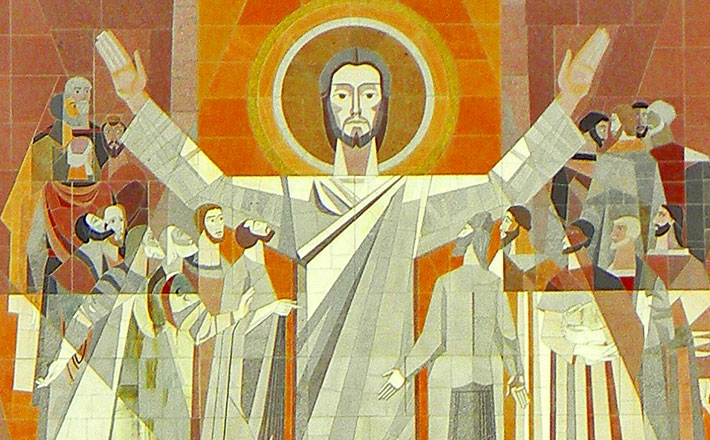Commentary on Acts 1:15-17, 21-26
For well over two centuries (or more correctly, for two or three millennia) scholars, pastors, lay leaders, skeptics, devout believers, and dedicated unbelievers have debated the truth and accuracy of scripture.
Errors, inconsistencies, and contradictions have been alleged, refuted, explained away (sometimes torturously), or accepted. Some see them as evidence that the Bible is not true. Others, as evidence that the Bible’s truth lies deeper than a tallying of facts and errors. Others encounter them as disruptions of their confidence in the Bible as a sacred text that leads to deeper relationship with God.
If persons gathered for worship do not have these philosophical/hermeneutical issues at the forefront of their minds as they enter worship, Acts can quickly bring them forward. As this pericope is read aloud in worship, anyone following along in a Bible or Bible app can easily notice that verses have been omitted (verses 18-20). One glance at Acts’ version of Judas’ death, as told in the omitted verses, leaves some listeners only a hyperlink away from Matthew 27:3-10. There Judas does not fall into a ravine, but, more famously, hangs himself. A measurable percentage of the congregation might wonder why the lectionary sidesteps the matter of two conflicting stories of Judas’ death. Other questions might follow: Acts and Matthew cite different scriptures to back up their accounts, raising questions about the citations themselves. Did David really write those cross-referenced Psalms? Why does Matthew cite Jeremiah when the one reference to buying a field with thirty pieces of silver comes from Zechariah?
Sermons are usually not the best medium for addressing these questions or the presuppositions underlying our interpretations. However, many in the pews puzzle over how to determine the ways that scripture leads us to truth or why inconsistencies or factual accuracy might matter sometimes and not others. If these matters are not best addressed from the pulpit on any given Sunday, it is worth considering when in the course of a year one’s congregation does dedicate time for such questions.
When trusted leaders betray
It seems clear that Judas’ betrayal of Jesus left a deep wound in early Christian communities. One act indelibly marks his name, his history, and the Church’s memory — Judas, the one who betrayed him. The four gospels make that connection twelve times (Matthew 10:4, 26:25. 27:3; Mark 3:19, 14:10; Luke 6:16, 24:48; John 6:71, 12:4, 13:2, 18:2, 18:5). The wound seems especially deep within the Johannine community. All four gospels convey a version of a woman anointing Jesus with expensive perfume (Matthew 26:6-13, Mark 14:3-9, Luke 7:36-50, John 12:1-8). All four report an objection being raised that the perfume was not sold for the poor — raised by “some of those present” in Mark, by the disciples in Matthew, by Simon the Pharisee in Luke, and in John, by “Judas Iscariot, one of his disciples (the one who was about to betray him).” Only John adds further commentary, “He said this not because he cared about the poor, but because he was a thief; he kept the common purse and used to steal what was put into it” (verse 6).
The reason Judas’ betrayal cuts so deep lies in the other way that all four gospels identify him — as “one of the Twelve” (Matthew 10:2-5, 26:47; Mark 3:14-9, 14:10, 20, 43; Luke 6:13-6, 22:3, 47; John 6:70-1). Powerful opponents might have called for Jesus’ execution, Pilate might have sentenced him to death, Roman soldiers might have nailed him to the cross, but they were outsiders. Judas was one of the most inside of the insiders. Our pericope relates a story of Peter, another of the Twelve, helping the community regroup, naming the pain of betrayal: “Judas, who served as guide for those who arrested Jesus … was one of our number and shared in our ministry” (Acts 1:16-7). When Jesus sent out disciples to preach, teach, and heal, Judas was among them. Except for John’s allegation that Judas was both betrayer and embezzler, the gospels offer no mention that, prior to Gethsemane, Judas was any less gifted or effective than any other of the twelve.
So, how do individuals or communities recover when a gifted spiritual leader goes dramatically astray? Does betrayal negate everything else Judas did? If someone in the first century were to look back on a lesson, a teaching, an act of healing performed by Judas, how would they put it into perspective or assess its value, its truth? In our own day, many individuals and communities face the same emotional aftermath following a radical betrayal of trust — anger, grief, confusion, loss of confidence in one’s judgment, or enduring suspicion of other people’s reliability. How can one help them move forward?
One must act carefully when selecting leadership after someone’s actions destroy a community’s sense of identity and integrity. This group knew, first, that they needed to replace Judas with someone with impeccable credentials — one who “accompanied us during all the time that the Lord Jesus went in and out among us, beginning from the baptism of John until the day when he was taken up from us” (verses 21-2). This person’s commitment must have remained intact beyond betrayal and death — unlike Judas — into the time of resurrection. Such a one can “become a witness with us to [Jesus’] resurrection” and embody the possibility of resurrection and new life within the community as well. They knew, second, that the replacement must be made after extended prayer involving the whole community (1:14). Prayer offers its own healing, especially for a wounded group seeking restoration. The community that prays together, heals together.
Many communities today would not see the Holy Spirit guiding such a crucial decision through the casting of lots. But the lot is the least important, least required element of their process then or our process now. Whether by lot, interview, or committee vote, the way forward that offers the surest prospect of new life after betrayal focuses on listening and discerning through extended communal prayer, finding people of rich experience and deep integrity, and ending with some sign that this next person is called by God — however a given community makes that determination. The scars left by Judas or others who betray and damage those around them will remain, but they do not need to define or stop a community’s ministry. God will make a way for people of resurrection to rise.


May 17, 2015